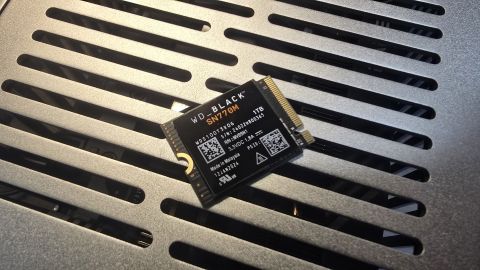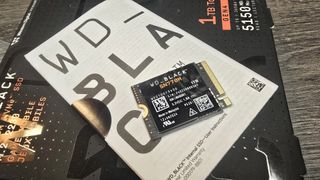Our Verdict
Although it lacks the sequential punch of some of its competitors, random 4K performance is top-tier, making it ideal for gaming handhelds, and for those on a budget looking to maximize those load times.
For
- 1TB pricing is stellar, particularly when deals land
- Top-tier random 4K performance
- Keeps up with larger QLC drives
Against
- Load times are slow comparatively
- Can get quite hot
PC Gamer's got your back
PC gaming has always had a bit of a tenuous history when it comes to the portability of its endeavors. The fact is that for the longest time those same chips that powered our high-end gaming desktops were just too hungry to be baked into a handheld gaming console. Flash forward to the launch of the Steam Deck though, (sorry Elgato), and at last we finally have an absolute armada of new handhelds entering the fray. All of them priced aggressively, kitted out with enough top-tier hardware to make for an engaging and enjoyable gaming experience on the move. But, there’s a caveat, as there often is, and it comes in the form of storage.
It’s one of those things right? If you don’t have enough of it in your gaming PC, it sucks. You’re constantly battling, deleting, re-downloading, perpetually anxious about your new games failing on the install. Manufacturers being the way they are, typically don’t include large drives in their handhelds either. That’s where Western Digital’s WD_Black SN770M 1TB comes into the picture.
It was perhaps unsurprising given the success and flurry of handhelds making their way into the arena, that we also wouldn’t be greeted with an arsenal of SSDs to back them up. After all a number of us may have mistakenly held back the cash and picked up a cheaper 512GB or worse still 256GB Steam Deck on launch, and well with a few installs, likely saw that little red bar demand you delete some of your hard earned games before installing more.
But you know all that, it’s been some time since the Steam Deck first launched, (in fact the Steam Deck OLED’s landed since then, albeit still with a PCIe 3.0 SSD) so the better question is, now that time has passed and there’s an array of these M.2 2230 drives out there in the wild, is Western Digital’s legendary black line, particularly in the form of its SN770M 1TB, still as competitive as it was before?
Well that’s what I’m here to both test and answer for you.
As with most of these small form factor drives, there’s an interesting combination of hardware at play here. Unlike the bevy of PCIe 5.0 drives that all feature the same Phison E26 controller combined with Micron’s 232-layer TLC NAND, the SN770M packs one of Sandisk’s (a subsidiary of WD) 20-82-10081-A1 controllers combined with some really slick TLC NAND Flash.
It’s DRAM less, there’s no cache here or anything of that ilk, but that’s all we really know about it. Although at first glance it might seem curious that WD has broken away from what it did with its WD Black SN770 full-sized drive (going with Toshiba’s 112-layer BiCS5 TLC) and instead utilizing Kioxia’s 112-layer, this is purely a branding exercise as Kioxia is part of Toshiba as a whole.
So it’s the same as the WD SN770 then? Well not quite, that single-sided design, and singular chip with the lack of a cache, doesn’t give WD much wiggle room when it comes to overall performance. On top of that, the one thing we do know about that Sandisk controller is that it’s based on an older 16nm process. Given the form factor, that’s inevitably going to make it hot under load for prolonged periods without suitable cooling. Less than ideal if it’s trapped in an enclosed small ROG Ally.
For my own testing I’m running all of these drives through a selection of benchmarks utilizing Asus’s ROG Strix X870E-E Gaming WiFi motherboard in conjunction with AMD’s Ryzen 9 9900X chip. That does mean this thing is covered by a seriously thick heatsink giving it some help in those longer-form benchmarks such as I/O meter and 3D Mark’s storage test. But as I’m doing this across all the drives, and it’s typically in workloads that aren’t synonymous with gaming handhelds, it shouldn’t affect my overall conclusion at all.
So how does it do then? Well sequential performance was pretty much close to as advertised, clocking in 5.2GB/s on the read and 5.0 GB/s on the write. Random 4K performance also pumped out 79 and 305 MB/s respectively across the two tests.


✅ You want the best value upgrade for your handheld PC: this drive is regularly on offer and usually excellent value for money.
❌ You want more capacity: the Crucial P310 is a better pick for 2 TB but you really have to ask yourself whether you need all that room on a portable machine.
Now compared to something like Crucial’s P310, that is markedly slower on the sequential performance for sure, however you’re really not likely to see sequential workloads that often on a handheld. The 4K performance on the other hand was much tighter, with the WD SN770M pipping the Crucial to the post in the read (79 MB/s to 76 MB/s), but losing out in the write test, nipping at its tail by 10 MB/s. That’s something that 3D Mark agrees with too, running both drives through its storage test, and the scores are just so incredibly tight. The Crucial landed a score of 3,075 to the SN770M’s 3,056. Similarly bandwidth was equally within a percent of each other, and access time was identical at 59 ns.
Jump over to the load tests with Final Fantasy XIV Shadowbringer and the SN770M is the slowest of the bunch on test, at a positively (not really) sluggish 8.389 seconds. That is slower than the P310’s 8.101 albeit not by much. Now, I’ve spoke about this at length in the Crucial P310 review, but the reality is it’s incredibly difficult to perceive that from a real-world perspective.
So where’s the big victory then? Is the WD Black SN770M the best SSD for your MSI Claw today? Should you keep an eye on it this Black Friday? Honestly yes. Although it might not have the capacity in this 1TB variant compared to the 2TB P310, the reality is it performs equally well and it does so at staggeringly low cost by comparison. As I write this it’s currently listed at just $90 for the 1TB variant, it’s not even a holiday. In fact it’s fallen as low as $85 in the past, and with the way NAND pricing is currently going, I highly expect it’ll fall further than that too.
It’s not perfect. Under long strenuous loads this thing gets toasty, and its performance is just ever so slightly shy of more modern designs like the P310, or larger PCIe 4.0 drives like Lexar’s NM790, but for what it’s intended to do, and how it operates, it honestly is top-tier and well worth considering.
Although it lacks the sequential punch of some of its competitors, random 4K performance is top-tier, making it ideal for gaming handhelds, and for those on a budget looking to maximize those load times.
After graduating from the University of Derby in 2014, Zak joined the PC Format and Maximum PC team as its resident staff writer. Specializing in PC building, and all forms of hardware and componentry, he soon worked his way up to editor-in-chief, leading the publication through the covid dark times. Since then, he’s dabbled in PR, working for Corsair for a while as its UK PR specialist, before returning to the fold as a tech journalist once again.
He now operates as a freelance tech editor, writing for all manner of publications, including PC Gamer, Maximum PC, Techradar, Gamesradar, PCGamesN, and Trusted Reviews as well. If there’s something happening in the tech industry it’s highly likely Zak has a strong opinion on it.

